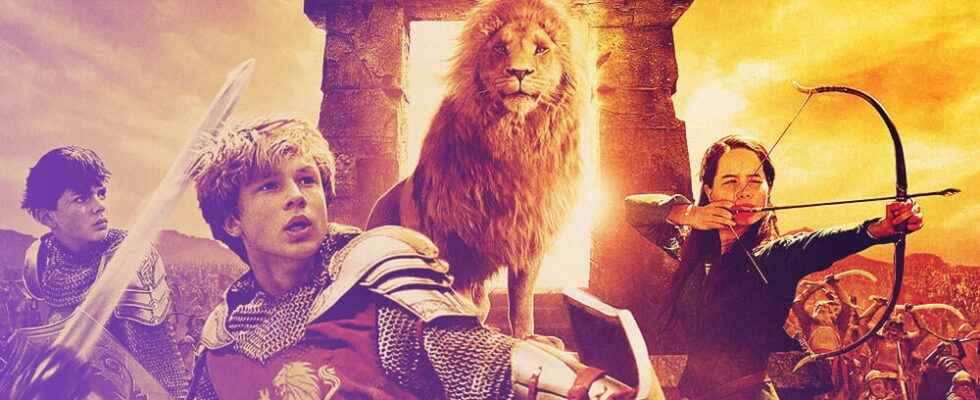At the beginning of the week we finally received new information about the planned Narnia film adaptation from Netflix. It’s been four years since the streaming service secured the rights to the series of novels created by CS Lewis. It was questionable whether the project was still up-to-date at all. Netflix regularly reassesses its content strategy even stomps running productions a. It didn’t hit Narnia though.
After four years of radio silence, there is talk of two (!) films and an extremely exciting director: Greta Gerwig, who will bring the Barbie adaptation with Margot Robbie to the cinema next year, is to start with the Narnia double launch new Netflix franchise. This is unexpectedly exciting news. But the implementation of Lewis’ seven-part series requires more than a cool director’s name.
Large-scale fantasy project on Netflix: Narnia is popular, but also messy
The first question is which of the books Netflix wants to film at all. Unlike a fantasy series like Harry Potter, which follows a clear protagonist over seven parts, The Chronicles of Narnia only conditionally a red thread turn off. The order of publication of the books does not correspond to the chronological sequence of events – there are many insertions and additions.
The trailer for the last Narnia film so far:
The Chronicles of Narnia: The Voyage of the Dawn Treader – Trailer (German)
The King of Narnia, published in 1950, was the first novel that introduced us to the four most well-known Narnia characters: the
Pevensie siblings Peter, Susan, Edmund and Lucy. Aside from Aslan, the messianic lion, they are the heart of the series. However, they do not appear consistently in every volume, nor do they always appear together. In the chronologically first story they are missing completely.
All Narnia books in chronological order:
Most adaptations choose The King of Narnia as their opening. There are already four films (two films and two series). It is not uncommon for this one volume to remain. Only the BBC put Prince Caspian, the Dawn Treader and the Silver Chair in further seasons of a Narnia series, while the cinema films initiated by Disney include The King, Prince Caspian and the Dawn Treader.
The Miracle of Narnia and The Third After Narnia have never been filmed, let alone the fantasy saga’s grand finale. Lewis’ template as a whole lacks the structure that we an overarching goal in mind sets for the story to work toward. For a large film and series franchise like Netflix is planning, this can definitely become a problem. But it’s not the only challenge.
Netflix’s Narnia film conflicts with the times: young stars and outdated text
Similar to Harry Potter, the film adaptation of Narnia is a race against time as the protagonists are children and teenagers. The production must therefore be completed quickly before the actors grow out of their roles. In addition, the raw material needs to be revised and modernized. Disney’s The King of Narnia was criticized on this point in 2005.
©Disney
The Chronicles of Narnia – The King of Narnia
It’s no secret that the Narnia books are steeped in biblical motifs and Christian conservative world view represent. It’s hard to imagine Netflix unthinkingly adopting the unmissable subtext for its global audience. Narnia is a popular fantasy subject with a lot of potential – but it also requires a whole mountain of work coming up on the streaming service.
Building a large franchise requires calm, patience and diligence. Netflix regularly fails in these disciplines, as failed brand takeovers à la Resident Evil and Cowboy Bebop have unfortunately shown very impressively. However, there is a glimmer of hope for Narnia: Matthew Aldrich, who was hired as the company’s architect long before the Greta Gerwig message.
The secret architect behind Netflix’ Narnia film comes from Pixar
Aldrich isn’t a big name, but he learned from one of the best places in Hollywood when it comes to to develop stories. As a (consulting) screenwriter, he was involved in the Pixar surprise hit Coco and the Toy Story offshoot Lightyear. An original idea and a franchise expansion: In both films we get to know fascinating worlds that inspire wonder and feel tangible.
While we thought the project was dead, Aldrich has been quietly working on Netflix’s Narnia, hopefully laying a stable foundation so we don’t see the streaming service’s next rush job. Another film adaptation of The King of Narnia included franchise hull the world really doesn’t need it.
*. .
Do you think Netflix is up to the Narnia challenge?
